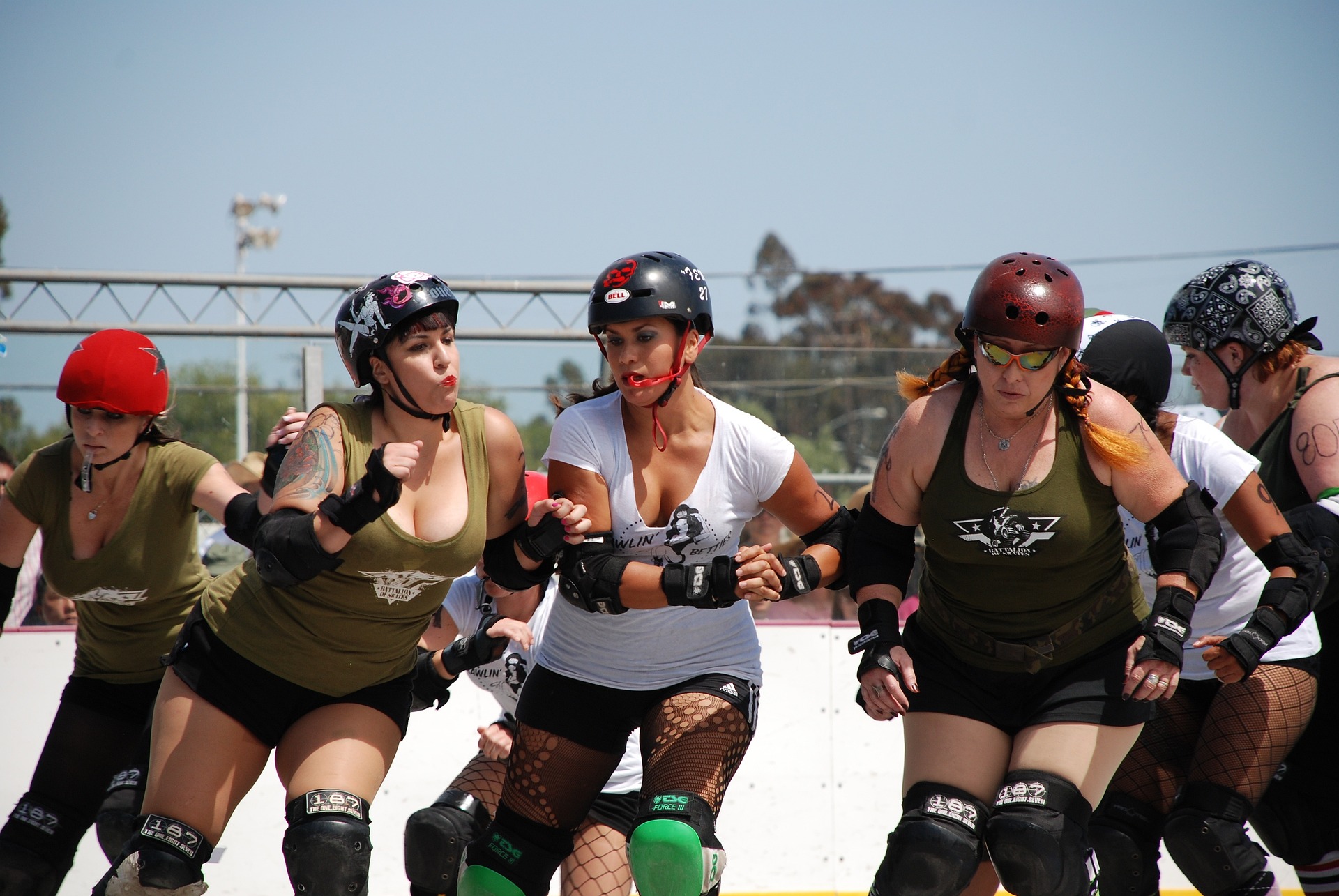Exploring the Resurgence of Roller Derby: From Grassroots to Global Phenomenon
In dimly lit warehouses and community centers across the globe, a revolution on wheels is taking place. Roller derby, once relegated to the annals of vintage Americana, has roared back to life with a vengeance. This full-contact sport on roller skates has captivated a new generation of athletes and spectators, blending athleticism, strategy, and a punk rock ethos into a unique sporting experience. As we lace up our skates and dive into the world of roller derby, we'll explore how this grassroots movement has evolved into a global phenomenon, challenging traditional notions of sport and gender along the way.
The modern roller derby renaissance began in the early 2000s in Austin, Texas. A group of women, inspired by the sport’s history and seeking an alternative to traditional athletics, formed the Texas Rollergirls in 2001. This DIY approach, coupled with a punk rock aesthetic and emphasis on female empowerment, struck a chord with many. Soon, leagues began popping up across the United States and beyond, each with its own unique flavor but united by a common love for the sport.
Unlike its predecessors, modern roller derby is primarily played by women, though men’s and co-ed leagues exist. The sport has shed much of its theatrical elements in favor of genuine athletic competition, while still maintaining its rebellious spirit and inclusive ethos.
The Mechanics of Modern Roller Derby
At its core, roller derby is a fast-paced, strategic game played on an oval track. Two teams of five skaters each compete in two-minute “jams.” Each team has one designated scorer, called a jammer, who earns points by lapping members of the opposing team. The other four skaters, known as blockers, play both offense and defense simultaneously, trying to help their jammer through while impeding the opposing jammer.
The physical demands of roller derby are intense. Skaters must possess speed, agility, and strength, all while maintaining balance on quad roller skates. Strategic thinking is equally important, as teams must constantly adapt their formations and tactics based on the ever-changing dynamics of the game.
Safety is a primary concern in modern roller derby. Players wear helmets, mouth guards, and protective pads, and strict rules govern legal contact. Despite its reputation as a rough sport, roller derby has a lower injury rate than many traditional contact sports, thanks in part to these safety measures and comprehensive training programs.
Beyond the Track: The Culture and Community of Roller Derby
What truly sets roller derby apart from other sports is its unique culture. From the colorful uniforms and punny skater names to the DIY ethos that permeates every aspect of the sport, roller derby has created a community unlike any other in the athletic world.
Inclusivity is a cornerstone of roller derby culture. The sport welcomes participants of all body types, ages, and backgrounds, challenging traditional notions of what an athlete should look like. This inclusive approach extends beyond the track, with many leagues actively involved in community outreach and social justice initiatives.
The do-it-yourself spirit that birthed the modern roller derby revival continues to thrive. Many leagues are run entirely by the skaters themselves, who handle everything from organizing bouts to managing finances. This hands-on approach fosters a deep sense of ownership and community among participants.
Roller derby has also become a powerful vehicle for personal growth and empowerment. Many skaters report increased confidence, improved body image, and a sense of belonging that extends far beyond the track. The sport’s emphasis on teamwork and mutual support creates a unique environment where competition and camaraderie coexist harmoniously.
The Global Spread: Roller Derby’s International Appeal
What began as a grassroots movement in Texas has blossomed into a global phenomenon. As of 2023, there are over 2,000 roller derby leagues worldwide, spanning six continents. The sport’s rapid growth can be attributed to several factors, including its adaptability to different cultures and its appeal to those seeking an alternative to traditional sports.
In Europe, roller derby has taken root in countries like the United Kingdom, Germany, and France, each putting their own spin on the sport while maintaining its core principles. The European Roller Derby Tournament, first held in 2009, has become a major event in the international derby calendar.
Asia has seen a surge in roller derby popularity, with leagues forming in Japan, China, and India. These teams often face unique challenges, from finding suitable venues to overcoming cultural barriers, but their persistence has helped establish roller derby as a truly global sport.
Latin America has embraced roller derby with particular enthusiasm. Countries like Argentina, Brazil, and Mexico boast thriving derby scenes, with the sport often intertwining with local cultural elements and social movements.
The Road to Recognition: Roller Derby’s Olympic Aspirations
As roller derby continues to grow and evolve, many within the community have set their sights on the ultimate goal of Olympic recognition. The path to becoming an Olympic sport is long and complex, but roller derby has made significant strides in recent years.
In 2018, the International Olympic Committee (IOC) granted provisional recognition to the World Skate Federation, the international governing body for roller sports, including roller derby. This recognition is a crucial first step toward potential Olympic inclusion, though many hurdles remain.
To meet Olympic standards, roller derby must continue to standardize its rules and regulations across international competitions. The sport must also demonstrate its global appeal and ability to attract spectators and media attention.
Proponents argue that roller derby’s inclusion would bring a fresh, dynamic element to the Olympic program, potentially attracting younger audiences and promoting gender equality in sports. Critics, however, worry that Olympic recognition might lead to a loss of the sport’s unique culture and grassroots spirit.
Challenges and Opportunities: The Future of Roller Derby
As roller derby enters its third decade of revival, it faces both challenges and opportunities. One of the primary hurdles is increasing mainstream visibility and recognition. While the sport has a dedicated following, it has yet to break through to wider audiences in the way that some other alternative sports have managed.
Financial sustainability is another ongoing concern for many leagues. The DIY ethos that defines roller derby can sometimes make it difficult to secure sponsorships and media deals that could provide much-needed funding. Some leagues have experimented with professional models, but striking a balance between financial viability and maintaining the sport’s core values remains a delicate task.
The COVID-19 pandemic presented unprecedented challenges to roller derby, as it did to all contact sports. Many leagues were forced to suspend operations, and the long-term impacts on membership and community engagement are still being felt. However, the crisis also spurred innovation, with virtual training sessions and online community events helping to keep the spirit of derby alive during lockdowns.
Looking ahead, roller derby has numerous opportunities for growth and development. The sport’s emphasis on inclusivity and empowerment aligns well with growing societal focus on diversity and gender equality in sports. As awareness of the sport increases, there’s potential for greater media coverage and sponsorship opportunities.
Technological advancements may also play a role in roller derby’s future. Improved streaming capabilities could bring the excitement of derby to a global audience, while developments in protective gear could enhance safety and performance.
Youth Programs: Nurturing the Next Generation of Derby Athletes
One of the most promising developments in the world of roller derby is the growth of youth programs. These initiatives introduce children and teenagers to the sport, fostering a new generation of skaters and ensuring roller derby’s long-term sustainability.
Junior derby programs typically cater to skaters aged 7-17, with modified rules to ensure safety while maintaining the core elements of the sport. These programs not only teach skating skills and derby strategy but also emphasize important life lessons such as teamwork, perseverance, and self-confidence.
The benefits of youth roller derby extend beyond the track. Participants often report improved physical fitness, better social skills, and a stronger sense of self-esteem. For many young people, especially those who may not fit into traditional sports programs, roller derby provides a welcoming community and an outlet for self-expression.
As these junior skaters grow and develop, they bring fresh energy and perspectives to adult leagues, helping to evolve the sport. Many of today’s top adult skaters began in junior programs, demonstrating the long-term impact of these initiatives.
The Science of Roller Derby: Athletic Performance and Injury Prevention
As roller derby has grown more competitive, there’s been an increased focus on the scientific aspects of training and performance. Sports scientists and medical professionals have begun to study the unique physical demands of roller derby, leading to more targeted training programs and injury prevention strategies.
One area of focus is the biomechanics of skating in a derby context. Understanding the forces at play during quick stops, direction changes, and impacts can help athletes improve their performance and reduce injury risk. Studies have shown that roller derby skaters experience significant lateral forces not typically seen in other sports, necessitating specific strength and stability training.
Nutrition science also plays a crucial role in roller derby performance. The sport’s high-intensity, intermittent nature requires carefully planned fueling strategies to maintain energy levels throughout a bout. Hydration is another key concern, particularly in hot environments or during tournament play where athletes may participate in multiple bouts in a single day.
Injury prevention remains a top priority in roller derby research. While safety measures have significantly reduced injury rates, the full-contact nature of the sport still presents risks. Studies are ongoing to develop better protective gear, improve training techniques, and identify risk factors for common derby injuries.
The Artistic Side of Roller Derby: Fashion, Design, and Self-Expression
While roller derby is first and foremost a sport, it has also spawned a vibrant artistic subculture. From uniform design to poster art, derby has become a canvas for creative expression that extends far beyond the track.
Uniform design in roller derby is an art form in itself. Teams often create elaborate, themed uniforms that reflect their personality and ethos. These designs can range from punk rock-inspired looks to intricate, narrative-driven concepts. The creativity extends to individual skaters as well, with many customizing their helmets, pads, and skates to express their personal style.
Roller derby has also inspired a wealth of visual art. Bout posters, often created by local artists, have become collectible items in their own right. These posters frequently blend elements of sports imagery with punk, pin-up, and comic book aesthetics, creating a unique visual language for the sport.
The performative aspect of roller derby extends to skater names and personas. Unlike most sports where athletes compete under their given names, derby skaters often adopt punny or intimidating alter egos. These names, which appear on uniforms and are used by announcers during bouts, add an extra layer of theatricality to the sport and allow skaters to explore different facets of their personalities.
Roller Derby in Popular Culture: Media Representation and Public Perception
As roller derby has grown in popularity, its representation in popular culture has evolved. Early depictions often focused on the sport’s more sensationalist aspects, emphasizing violence and spectacle over athleticism. However, as the sport has matured, so too has its portrayal in media.
Films like “Whip It” (2009), directed by Drew Barrymore, helped introduce roller derby to a wider audience. While the film took some creative liberties with the sport’s rules and culture, it captured the spirit of empowerment and community that defines modern roller derby.
Television has also played a role in shaping public perception of the sport. Documentary series and reality shows have offered behind-the-scenes looks at derby life, helping to demystify the sport and highlight the dedication of its athletes.
Social media has become a powerful tool for roller derby leagues and individual skaters to control their own narratives. Platforms like Instagram and TikTok allow derby athletes to showcase their training, bouts, and daily lives, providing an unfiltered look at the sport and helping to build a global derby community.
Despite these strides, roller derby still faces challenges in terms of mainstream acceptance and understanding. Many people’s perceptions of the sport remain rooted in its theatrical past, and educating the public about modern roller derby’s athletic legitimacy remains an ongoing task for the community.
The Business of Roller Derby: Leagues, Sponsorships, and Economic Impact
As roller derby has grown from a grassroots movement to a global sport, it has begun to develop more sophisticated business models. While many leagues maintain their volunteer-run, non-profit status, others have explored more professional structures.
The Women’s Flat Track Derby Association (WFTDA), the sport’s largest governing body, has played a crucial role in developing standardized rules and ranking systems. This standardization has helped create a more cohesive global derby community and has facilitated international competitions.
Sponsorship in roller derby presents unique challenges and opportunities. The sport’s countercultural image can make it a difficult sell to traditional sports sponsors, but it also opens doors to partnerships with alternative and local businesses that align with derby’s values.
Some leagues have found success by emphasizing the local economic impact of roller derby. Bouts can draw significant crowds, benefiting local businesses and contributing to the community’s economy. This angle has helped some leagues secure support from local governments and tourism boards.
Merchandise sales play a significant role in many leagues’ financial strategies. From team jerseys to novelty items, derby merchandise allows fans to support their favorite teams while providing a crucial revenue stream.
As the sport continues to grow, questions about professionalization and player compensation are becoming more prominent. While most derby athletes currently play for the love of the sport, some argue that top-level skaters should be able to make a living from their skills, similar to athletes in other sports.
Conclusion: The Enduring Appeal of Roller Derby
As we’ve explored the multifaceted world of roller derby, from its historical roots to its current global reach, one thing becomes clear: this is more than just a sport. It’s a movement, a community, and for many, a way of life.
Roller derby’s appeal lies in its unique blend of athleticism, strategy, and self-expression. It offers a space where competition and camaraderie coexist, where diversity is celebrated, and where individuals can challenge themselves both physically and mentally.
As the sport continues to evolve, it faces both challenges and opportunities. The push for Olympic recognition, the development of youth programs, and the ongoing task of increasing mainstream visibility all present potential pathways for growth. At the same time, maintaining the sport’s core values and unique culture in the face of potential commercialization remains a priority for many in the derby community.
Whatever the future holds, one thing is certain: roller derby has carved out a unique place in the sporting landscape. Its impact extends far beyond the track, empowering individuals, building communities, and challenging traditional notions of what sport can be. As long as there are those willing to lace up their skates and take to the track, roller derby will continue to roll on, leaving an indelible mark on the world of sports and beyond.






